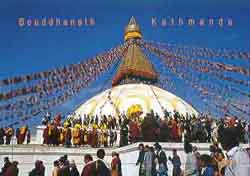|
LANGTANG RI can
arrange a variety of sight-seeing trips to complement your trek or rafting trip. These are
just a few of the places of interest that can be included in your tailor-made itinerary.
KATHMANDU
DURBAR SQUARE Kathmandu’s most impressive sight, Durbar Square is a
colourful hotch-potch of temples and palaces. It is also home to Kathmandu’s Kumari,
or ‘living goddess’, a young girl believed to be a reincarnation of the goddess
Durga.
SWAYAMBHUNATH Known as the ‘monkey temple’ because of its
resident swarm of apes, this spectacular Buddhist Stupa, from which the Buddha’s eyes
gaze serenely down, lies on a hilltop only 2km from Kathmandu. The views down over
Kathmandu and the surrounding valley are superb.
 BOUDHANATH 8km
from the city centre, this is Kathmandu’s largest Stupa. It’s especially
colourful on Saturdays, when Tibetan refugees flock here to pray.
PASHUPATINATH TEMPLE On the bank of the sacred Bagmati River, this Shiva
Temple is famous for its two-tiered golden roof and silver doors.
PATAN
The ancient city of Patan faces
Kathmandu on the southern bank of the River Bagmati. It’s a colourful place, with
Hindu temples and Buddhist monuments jostling side by side in its narrow, winding streets
and unexpected squares.
DURBAR SQUARE Exquisitely carved palaces, temples and shrines litter the
square, which is dominated by the ancient Royal Palace. Nestling in one corner is the
triple-roofed octagonal tower of the 17th Century Teleju Bhawani Temple.
KRISHAN MANDIR The first of its kind to be built, this 17th Century temple
is the only one in Nepal with entirely stone-carved shrines.
HIRANYA VARAN MAHAVIHAR A 12th Century, three-tiered Golden Pagoda of Lord
Buddha.
KUMBHESHWOR A Shiva Temple with an unusual five-tiered roof.
BHAKTAPUR
One of the three ancient cities of
Nepal, Bhaktapur is the home of medieval art and architecture, as well as thriving local
pottery and weaving industries
DURBAR SQUARE This spacious, beautiful square is packed from end to end
with ancient temples and monuments. These include the colourfully named ‘Lion
Gate’ and ‘The Bell of the Barking Dogs.’ It’s a great place to
explore for an hour or two and absorb the local life.
NYATAPOLA TEMPLE Dating back to 1702, this five-storey pagoda is an
impressive sight. Staring down at you from the terraces are intricately carved figures of
wrestlers, elephants, lions and griffins.
EXTENSSION
SERVICES CAN BE ORGANIZED THROUGH OUR SISTER CONCERNS TO FOLLOWING DESTINATIONS AND
ACTIVITIES. BOUDHANATH 8km
from the city centre, this is Kathmandu’s largest Stupa. It’s especially
colourful on Saturdays, when Tibetan refugees flock here to pray.
PASHUPATINATH TEMPLE On the bank of the sacred Bagmati River, this Shiva
Temple is famous for its two-tiered golden roof and silver doors.
PATAN
The ancient city of Patan faces
Kathmandu on the southern bank of the River Bagmati. It’s a colourful place, with
Hindu temples and Buddhist monuments jostling side by side in its narrow, winding streets
and unexpected squares.
DURBAR SQUARE Exquisitely carved palaces, temples and shrines litter the
square, which is dominated by the ancient Royal Palace. Nestling in one corner is the
triple-roofed octagonal tower of the 17th Century Teleju Bhawani Temple.
KRISHAN MANDIR The first of its kind to be built, this 17th Century temple
is the only one in Nepal with entirely stone-carved shrines.
HIRANYA VARAN MAHAVIHAR A 12th Century, three-tiered Golden Pagoda of Lord
Buddha.
KUMBHESHWOR A Shiva Temple with an unusual five-tiered roof.
BHAKTAPUR
One of the three ancient cities of
Nepal, Bhaktapur is the home of medieval art and architecture, as well as thriving local
pottery and weaving industries
DURBAR SQUARE This spacious, beautiful square is packed from end to end
with ancient temples and monuments. These include the colourfully named ‘Lion
Gate’ and ‘The Bell of the Barking Dogs.’ It’s a great place to
explore for an hour or two and absorb the local life.
NYATAPOLA TEMPLE Dating back to 1702, this five-storey pagoda is an
impressive sight. Staring down at you from the terraces are intricately carved figures of
wrestlers, elephants, lions and griffins.
EXTENSSION
SERVICES CAN BE ORGANIZED THROUGH OUR SISTER CONCERNS TO FOLLOWING DESTINATIONS AND
ACTIVITIES.
|
|
 .
. .
.